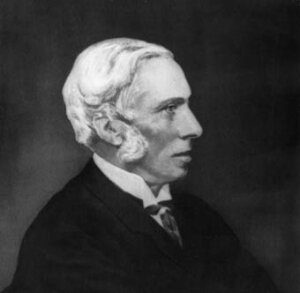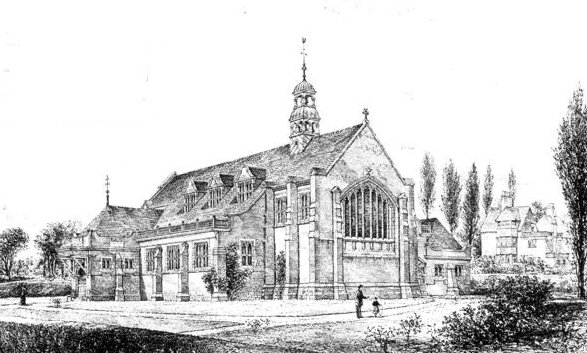
The Architects: Richard Norman Shaw
Sandra Grant profiles the most famous of them all of the architects who designed Bedford Park
This article is also available in pdf format
 Having cast off his first architect, Edward Godwin, after press criticism of his designs, in 1877 Jonathan Carr asked the better-known Richard Norman Shaw to draw up designs for his new garden suburb. It turned out to be an inspired commission as Shaw’s combination of practicality and the picturesque was to set the tone for Bedford Park.
Having cast off his first architect, Edward Godwin, after press criticism of his designs, in 1877 Jonathan Carr asked the better-known Richard Norman Shaw to draw up designs for his new garden suburb. It turned out to be an inspired commission as Shaw’s combination of practicality and the picturesque was to set the tone for Bedford Park.
He had to produce houses which were aesthetically pleasing, easy and cheap to construct, while nodding in the direction of Godwin’s prototypes. The result was a series of different designs, including terraced, detached and semi-detached houses. The style was known as Queen Anne revival, although it borrowed elements from Dutch architecture as well as old Sussex vernacular.
He also designed St Michael and All Angels Church (pictured below), the Tabard Inn, the Stores (now offices), Jonathan Carr’s own magnificent Tower House (since replaced by St Catherine‘s Court flats), and elements of the Club.

It is sometimes suggested that Norman Shaw also had a hand in planning the layout of Bedford Park, but this seems unlikely. He did not even supervise the construction of his own designs, and his drawings were often modified by builders and other architects.
Indeed, his connection with the suburb had ended by 1880, possibly because he had then become seriously ill, although he did later help amend Maurice B Adams’s School of Art designs "to prevent the immninence of bloodshed".
Born in 1831 in Edinburgh to a Scottish mother and Irish Protestant father (who died when he was two), he was articled around 1849 to William Burn in London, also studying at the Royal Academy, where he was a medal-winning pupil. After working for two other architects, he set up his own practice in London 1862/3 in a loose partnership with William Eden Nesfield. This lasted until 1868, although they continued to share offices until 1876. One of Norman Shaw’s first commissions came from his brother Robert, who had co-founded the Shaw Savill shipping line.
As his reputation grew he designed what Building News called "substantial, dignified, modern residences" – including his own in Hampstead – rather than huge palaces or castles, along with churches, institutions and commercial buildings. In the mid-1870s he followed the pattern of his contemporaries by designing furniture and fittings.
Always open to new ideas – he pioneered a method of concrete construction – he also had a strong sense of architectural history. He began by designing Gothic style buildings. Then he developed the Queen Anne Revival style which included not only Bedford Park but also Lowther Lodge in Kensington Gore, now the Geographic Society, and a Hampstead home for children’s artist Kate Greenaway. In 1887 he began one of his most famous buildings – the New Scotland Yard police headquarters in Westminster. His final flourish was what architectural writer Nikolas Pevsner called the "Baroque Edwardian-Imperial-Palladianism of the Piccadilly Hotel in 1905.
In 1890 he began an association with London County Council, assessing and amending major building schemes aimed at improving London architecture. Whatever the style, as an appreciation in The Builder of 1912 put it, his buildings achieved balance without resorting to rigid symmetry.
Constantly learning and refining his own skills, he was generous with his time and talent, happily allowing a succession of young pupils and assistants to put their own mark on various projects. He treated them and his clients with equal courtesy, often showing an ironic wit.
According to his contemporaries, he was tall, thin and distinguished looking, quick of mind, easily amused, suave and persuasive with his clients He described himself to one colleague: "You know I am not a Church man, I am a house man, and soil pipes are my speciality."
In 1867 he married Agnes Wood, 16 years his junior, with whom he had three children. His first-born, Elizabeth, joined the Sisterhood of Bethany (whose Bournemouth Convent was designed by her father in 1874).
The second, Robert, who also never married, had a nervous disability. The youngest, Willie, did marry but his wife died leaving him with three young children who all moved in to live with their grandparents.
As well as the noise of children playing, the Hampstead house also echoed to the sound of Norman Shaw’s collection of some 170 clocks.
By the time he closed his office in 1896 he was regarded as England’s greatest architect who had enormous influence on the Arts and Crafts movement. He continued to work on selected projects from his home until retiring fully in 1909. He died in 1912 and is buried in Hampstead.